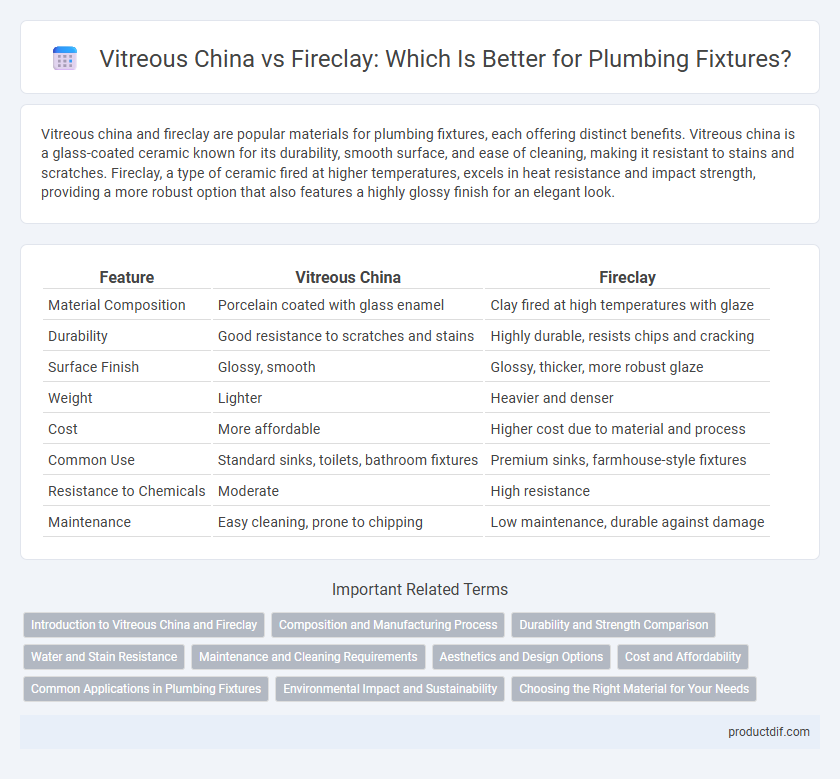Vitreous china and fireclay are popular materials for plumbing fixtures, each offering distinct benefits. Vitreous china is a glass-coated ceramic known for its durability, smooth surface, and ease of cleaning, making it resistant to stains and scratches. Fireclay, a type of ceramic fired at higher temperatures, excels in heat resistance and impact strength, providing a more robust option that also features a highly glossy finish for an elegant look.
Table of Comparison
| Feature | Vitreous China | Fireclay |
|---|---|---|
| Material Composition | Porcelain coated with glass enamel | Clay fired at high temperatures with glaze |
| Durability | Good resistance to scratches and stains | Highly durable, resists chips and cracking |
| Surface Finish | Glossy, smooth | Glossy, thicker, more robust glaze |
| Weight | Lighter | Heavier and denser |
| Cost | More affordable | Higher cost due to material and process |
| Common Use | Standard sinks, toilets, bathroom fixtures | Premium sinks, farmhouse-style fixtures |
| Resistance to Chemicals | Moderate | High resistance |
| Maintenance | Easy cleaning, prone to chipping | Low maintenance, durable against damage |
Introduction to Vitreous China and Fireclay
Vitreous china is a ceramic material coated with a layer of glass-like enamel, known for its glossy finish, durability, and resistance to stains and scratches in plumbing fixtures. Fireclay, made from molded clay fired at extremely high temperatures, offers superior hardness and chip resistance, making it ideal for sinks and basins exposed to heavy use. Both materials provide smooth, non-porous surfaces that enhance hygiene, but vitreous china is typically more widely used in toilets, while fireclay is favored for high-end kitchen and utility sinks.
Composition and Manufacturing Process
Vitreous china is composed of porcelain clay coated with a layer of glass-like enamel, fired at high temperatures to achieve a smooth, durable surface resistant to stains and scratches. Fireclay is made from a mixture of refined clay and minerals, fired at even higher temperatures, resulting in a dense, non-porous material with exceptional strength and chip resistance. The manufacturing process of vitreous china involves glazing and firing for a glossy finish, while fireclay undergoes prolonged high-temperature firing to enhance hardness and durability.
Durability and Strength Comparison
Vitreous china and fireclay are both durable materials used in plumbing fixtures, with fireclay offering superior strength due to its higher density and resistance to chipping and cracking under heavy impact. Vitreous china, while still strong and smooth-bodied, tends to be more prone to surface scratches and is less resistant to thermal shock compared to fireclay. Fireclay's enhanced durability makes it an ideal choice for high-traffic bathroom fixtures such as sinks and toilets, ensuring long-lasting performance and reduced maintenance.
Water and Stain Resistance
Vitreous china offers superior water resistance due to its glass-like coating, making it less porous and highly resistant to stains. Fireclay, while durable and resistant to heat, tends to be slightly more porous, which can result in more water absorption and potential staining over time. For plumbing fixtures where water and stain resistance are critical, vitreous china is often the preferred material due to its impermeability and ease of cleaning.
Maintenance and Cleaning Requirements
Vitreous china plumbing fixtures feature a glazed surface that resists stains and is easy to clean with mild detergents, making routine maintenance straightforward. Fireclay fixtures, made from a denser clay fired at higher temperatures, offer superior resistance to scratches and chipping, requiring less frequent deep cleaning but careful use of non-abrasive cleaners to prevent surface damage. Both materials benefit from regular wiping to prevent mineral buildup, though vitreous china may show wear over time with harsh chemicals, whereas fireclay maintains its finish longer under proper care.
Aesthetics and Design Options
Vitreous china offers a smooth, glossy finish with a wide range of shapes and styles, making it ideal for sleek, modern bathroom designs. Fireclay provides a matte, rustic appearance that enhances traditional or farmhouse aesthetics with its handcrafted look and unique glazing variations. Both materials support diverse design options, but fireclay's durability and texture appeal more to those seeking a timeless, artisanal feel.
Cost and Affordability
Vitreous china plumbing fixtures are generally more affordable due to lower manufacturing costs and widespread availability, making them a popular choice for budget-conscious homeowners. Fireclay fixtures, while durable and resistant to chipping, typically command a higher price because of their labor-intensive production process and premium materials. Cost considerations often lead consumers to choose vitreous china for everyday use, reserving fireclay for high-end or custom bathroom installations where long-term value is prioritized.
Common Applications in Plumbing Fixtures
Vitreous china is widely used in plumbing fixtures such as toilets, sinks, and urinals due to its smooth, non-porous surface and high resistance to stains and scratches. Fireclay, known for its exceptional durability and heat resistance, is commonly applied in farmhouse sinks and basins where heavy use and aesthetic appeal are prioritized. Both materials provide long-lasting performance but differ in cost and installation complexity, influencing their suitability across residential and commercial plumbing applications.
Environmental Impact and Sustainability
Vitreous china plumbing fixtures, composed primarily of refined clay and glazed with a glass-like coating, have a moderate environmental impact due to energy-intensive kiln firing processes and raw material extraction. Fireclay, a denser ceramic material fired at higher temperatures, offers enhanced durability and longer lifespan, reducing waste and replacement frequency, which contributes to improved sustainability. Both materials are recyclable, but fireclay's resistance to chipping and cracking typically results in fewer repairs and replacements, making it a more environmentally sustainable choice for long-term plumbing fixtures.
Choosing the Right Material for Your Needs
Vitreous china offers a glossy, durable surface that resists stains and scratches, making it ideal for everyday bathroom fixtures. Fireclay excels in durability and heat resistance, often preferred for farmhouse sinks and vintage-style installations due to its thicker, heavier composition. When choosing the right plumbing fixture material, consider factors like usage frequency, design preferences, and maintenance requirements to ensure long-lasting performance and aesthetic appeal.
vitreous china vs fireclay Infographic

 productdif.com
productdif.com